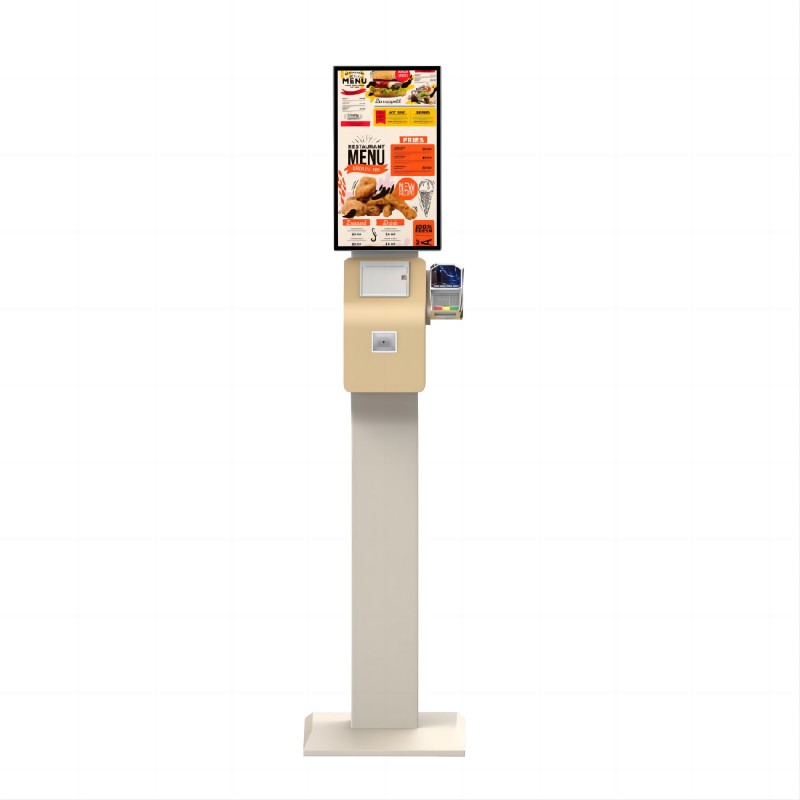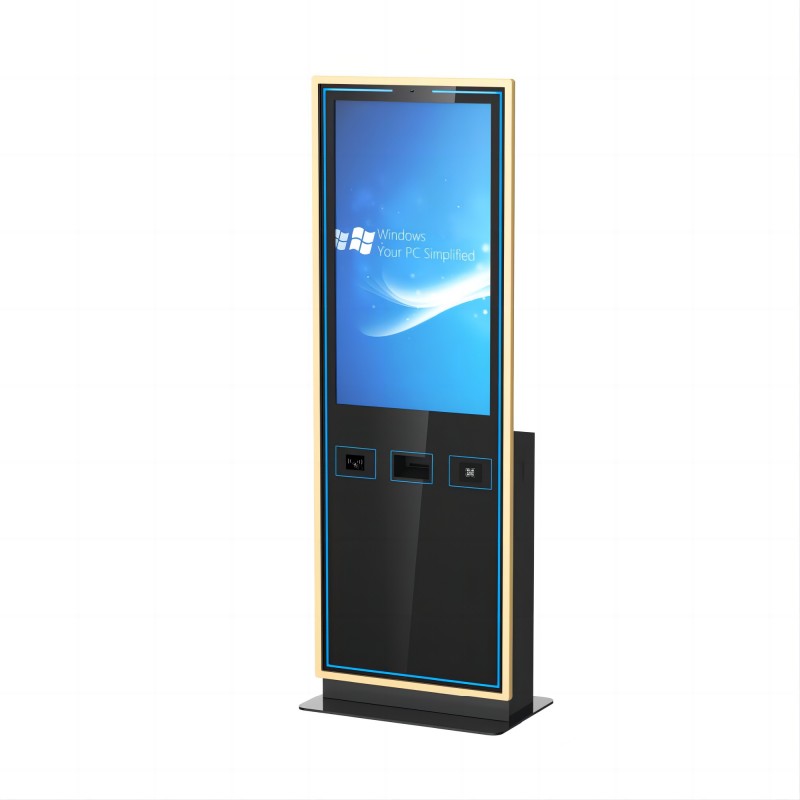| Component | Description | Purpose | Options |
|---|---|---|---|
| Touchscreen Display | Interactive monitor that responds to touch inputs | Provides a user interface for easy interaction and navigation | Varies in size (e.g., 15", 22") and resolution (HD, 4K) |
| Computer Hardware | Internal components including the CPU, RAM, storage drives, and motherboard | Powers the kiosk, processes data, and runs the software applications | Choices include integrated systems or external PC units |
| Enclosure | The outer casing or frame of the kiosk, made from materials such as metal, plastic, or wood | Houses and protects the internal components while providing a durable and aesthetic exterior | Customizable in design, color, and material for brand alignment |
| Peripheral Devices | Optional add-ons like thermal printers, barcode scanners, RFID readers, and card readers | Extends the functionality of the kiosk for tasks like printing tickets, scanning barcodes, or processing payments | Options for integration or external attachment depending on needs |
A standing computer kiosk operates as a self-service terminal designed for user interaction and information processing. Users engage with the kiosk through a touchscreen display, which allows them to navigate menus and input data. The kiosk's internal computer hardware processes these inputs and executes the necessary software applications. Depending on the kiosk's purpose, it might interact with peripheral devices such as printers for receipts, barcode scanners for product information, or card readers for transactions. The kiosk's enclosure protects and houses these components, ensuring durability and accessibility. By integrating various hardware and software elements, standing computer kiosks streamline tasks, enhance user experience, and support efficient operations in public spaces.

Approach the Kiosk: Stand close to the kiosk and ensure you are within reach of the touchscreen and any other interactive elements.
Select Your Language: Choose your preferred language from the available options on the screen, if applicable.
Follow On-Screen Instructions: Read and follow the instructions displayed on the touchscreen to navigate through the kiosk’s menu or service options.
Input Information: Use the touchscreen to enter necessary information, such as personal details, payment information, or search queries.
Use Peripheral Devices: If needed, interact with additional devices like barcode scanners or card readers to complete transactions or provide necessary information.
Review and Confirm: Check the information you’ve entered or the options you’ve selected. Confirm your choices or complete the transaction as instructed.
Print or Collect Receipts: If the kiosk provides printed receipts or tickets, retrieve them from the printer. If the service includes digital confirmation, check your email or other provided options for confirmation.

Self-Check-In: Used in airports, hotels, and events to allow users to check in independently, reducing wait times and improving efficiency.
Information Lookup: Provides access to information such as store directories, maps, and FAQs in shopping malls, museums, and public places.
Ticketing: Allows users to purchase or print tickets for transportation, events, or attractions, streamlining the ticketing process.
Order Placement: Enables customers to place orders at restaurants, fast food outlets, and retail stores, enhancing the speed of service.
Payment Processing: Facilitates transactions for services such as parking fees, utility bills, and fines, offering a convenient self-service option.
Queue Management: Helps manage queues by allowing users to check their place in line and receive updates, commonly used in government offices and service centers.
Customer Surveys: Collects feedback from customers or visitors through interactive surveys or questionnaires to improve services and gather insights.
Product Information: Provides detailed information about products in retail environments, including specifications, pricing, and availability.

Standing computer kiosks serve to enhance user convenience and operational efficiency across various settings. They are designed to streamline processes by offering self-service options for checking in, ordering, paying, and accessing information. By automating tasks, these kiosks reduce the need for human intervention, minimize wait times, and improve overall customer satisfaction. Additionally, they can handle high volumes of users, support diverse applications, and integrate with other systems for seamless functionality.

Design and Planning: The process begins with designing the kiosk based on its intended purpose, functionality, and user requirements. This involves creating detailed blueprints and selecting appropriate materials.
Component Selection: Key components such as the touchscreen display, computer hardware, peripherals (printers, scanners), and enclosure materials are chosen based on the kiosk’s specifications.
Fabrication: The kiosk’s enclosure is constructed using materials like metal, plastic, or wood. This includes cutting, welding, and assembling parts to form a sturdy and functional frame.
Hardware Assembly: Internal components, including the computer unit, touchscreen display, and any additional peripherals, are installed into the enclosure. This involves wiring and securing each component.
Software Installation: The kiosk’s operating system and application software are installed and configured to ensure the kiosk performs its intended functions.
Testing and Quality Assurance: The completed kiosk undergoes rigorous testing to ensure all components work correctly and the system operates smoothly. Any issues are addressed before the final deployment.
Deployment and Installation: The kiosk is transported to its intended location, assembled (if necessary), and installed. Final adjustments and calibrations are made to ensure proper functionality.
Design and Branding: Customizable in terms of color, material, and design to align with brand identity and aesthetic preferences.
Screen Size and Type: Options for different screen sizes and types (e.g., LED, touch-sensitive) to suit various applications.
Hardware Configuration: Choice of internal hardware components, including processors, memory, and storage, based on performance needs.
Peripheral Integration: Ability to include or exclude peripherals like printers, scanners, and card readers based on functional requirements.
Software Customization: Tailoring of software applications to meet specific operational needs and user interactions.
Enclosure Features: Custom features such as adjustable stands, security locks, or weatherproofing for outdoor use.
Accessibility Options: Adaptations for accessibility, including height adjustments and support for various input methods.
Purpose and Functionality: Clearly define the kiosk’s intended use to select the right features and specifications.
Budget: Determine the budget, including initial costs, installation, and potential ongoing maintenance.
Location: Consider the kiosk’s installation environment (indoor/outdoor) and ensure it meets environmental and safety requirements.
Customization Needs: Identify necessary customizations and verify that the manufacturer can accommodate these requirements.
Integration: Ensure the kiosk can integrate with existing systems or software used by your organization.
Support and Maintenance: Check for available support services, warranty options, and ease of maintenance to ensure long-term functionality and reliability.
What did our happy clients say?
The standing computer kiosk exceeded our expectations with its sleek design and user-friendly interface. It’s been a huge hit with our customers and streamlined our check-in process.
We’re thrilled with our new standing computer kiosk! It’s robust, easy to set up, and integrates perfectly with our system. Great investment for our business.
The kiosk looks fantastic and operates flawlessly. It’s enhanced our customer service and allowed for efficient transactions. Highly recommend this product!
Impressed by the quality and performance of our standing computer kiosk. It’s durable, stylish, and functional. The customization options were spot on for our needs.